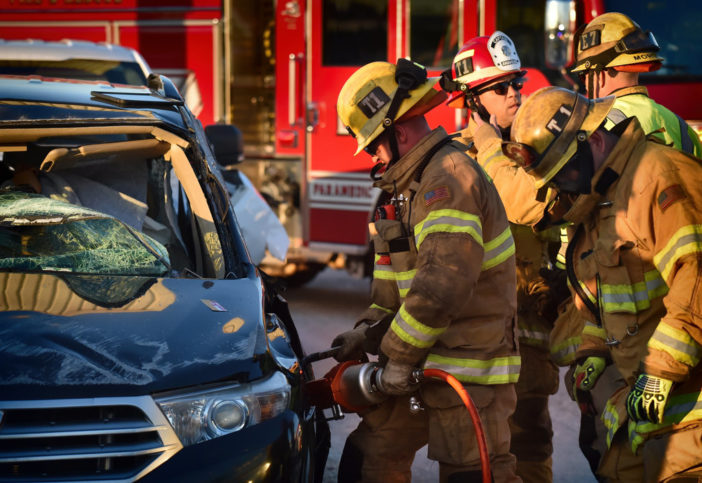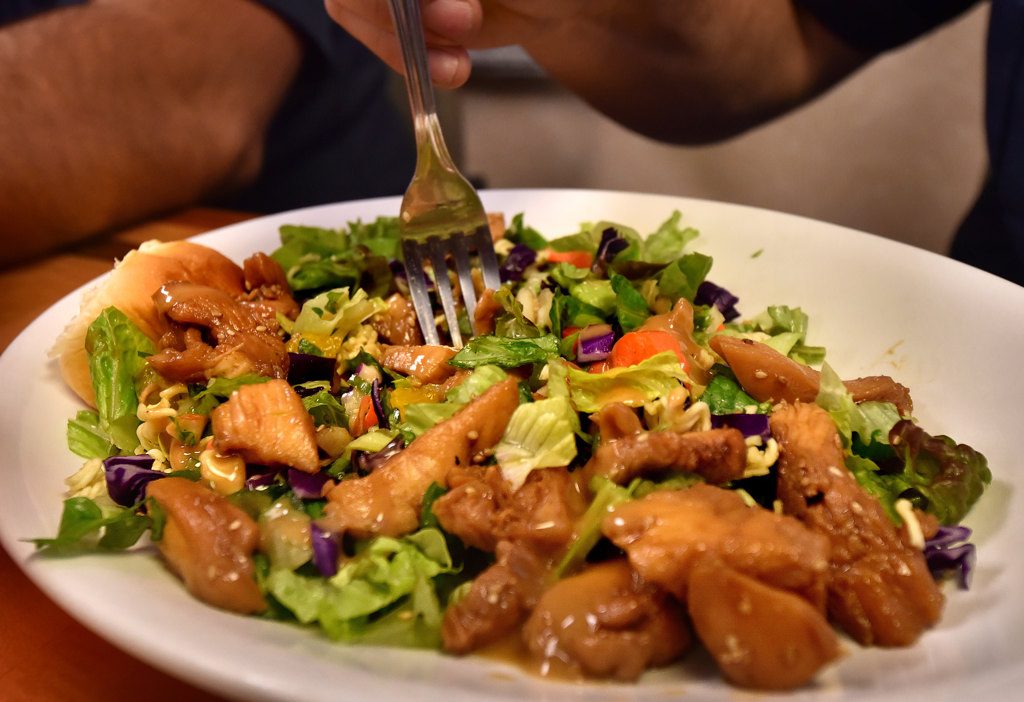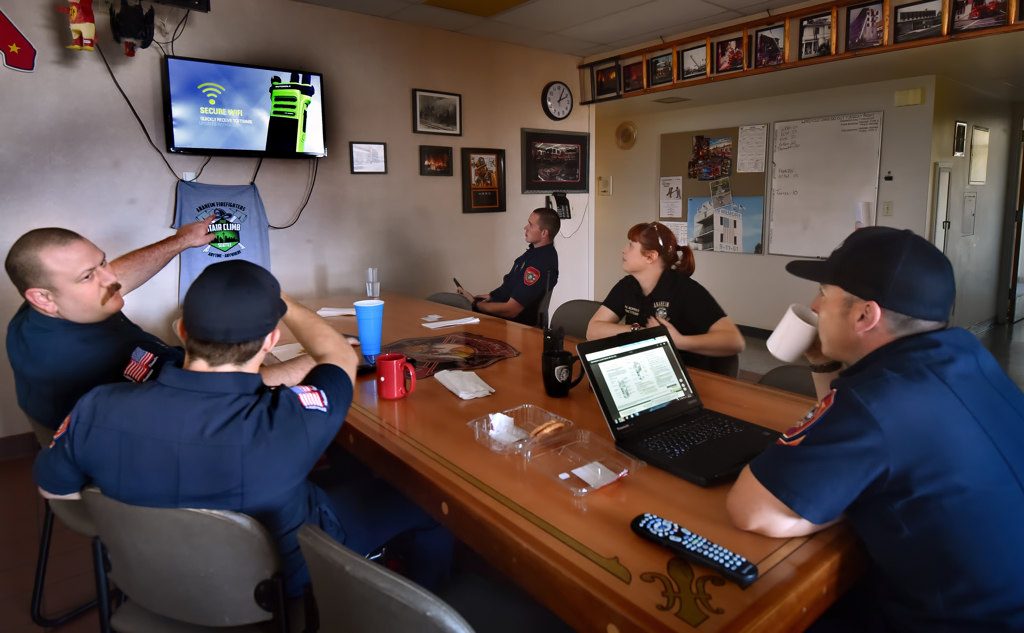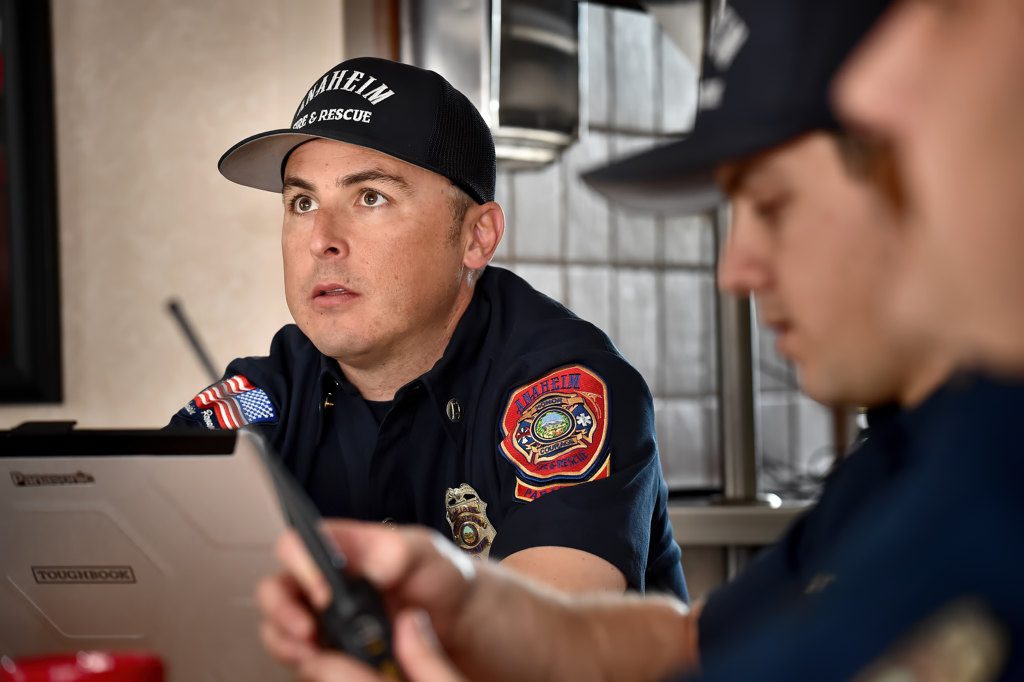The firefighters sit around the chow table, a reclaimed bowling lane bearing an insignia of Station 1, one of the busiest of Anaheim Fire & Rescue’s 11 stations.
It’s 8 a.m. on a recent Friday, the start of a 24-hour shift for eight firefighters and two Care Ambulance Service EMTs (emergency medical technicians) who also live and work out of the station at 500 E. Broadway, located just a couple of blocks away from Anaheim City Hall and AF&R headquarters.
The firefighters — four attached to an engine, four to a truck — and EMTs barely have a chance to warm their seats and finish their coffee when, at 8:05 a.m., the first call comes in.
Possible stroke, 54-year-old female.
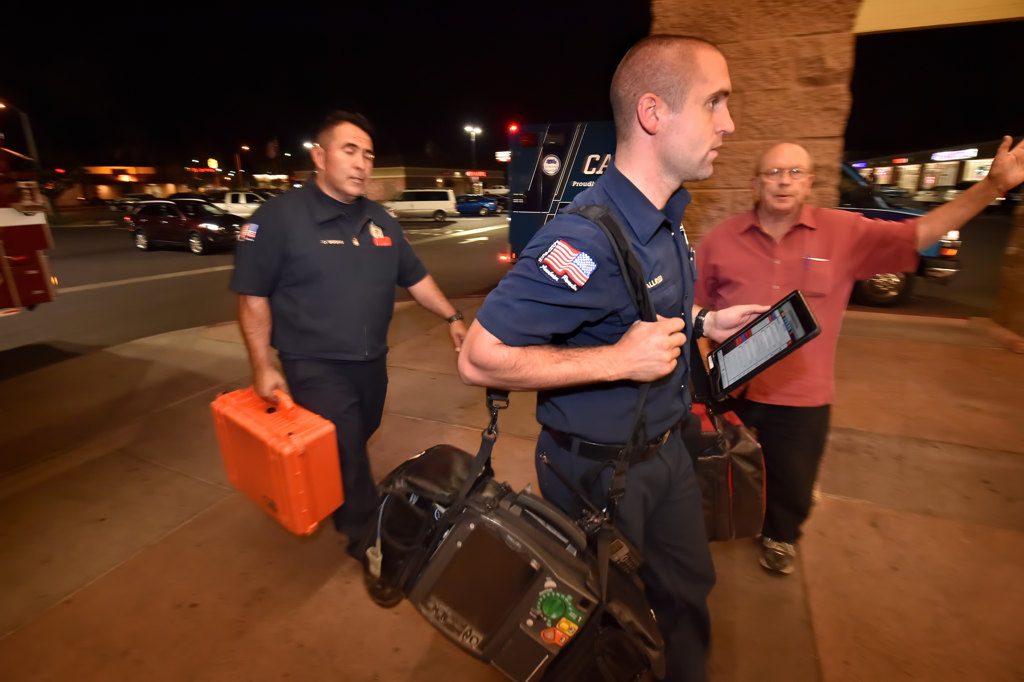
Firefighter Dennis Biggins, left, and Probationary Firefighter Ryan Allred arrive at a supermarket on a medical aid call.
Photo by Steven Georges/Behind the Badge OC
Within two minutes, Truck 1 and the ambulance are off, sirens blaring and lights flashing, to a home about a mile away.
The truck and engine crews alternate calls when possible to maintain some semblance of sanity at a station that averages 20 calls per 24-hour shift, more than 80 percent of them for medical aid.
“There’s no normal,” probationary Firefighter Ryan Allred says of a typical day at Station 1.
As the shift proves, even getting lunch and dinner is a challenge.
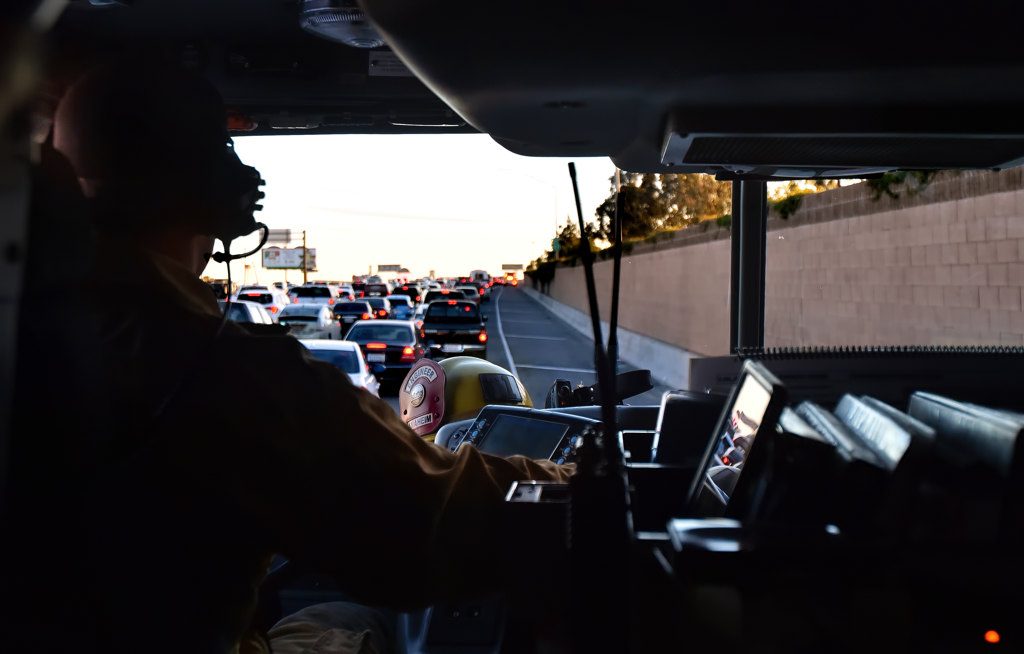
Anaheim Fire & Rescue Truck 1 rides the shoulder of the 57 Freeway with lights flashing and sirens on, occasionally giving an extra horn to those cars getting in the way, as it heads toward a multi-vehicle collision just after 5 p.m. on Friday, Feb. 16.
Photo by Steven Georges/Behind the Badge OC
But challenges are the norm at a firehouse, a true home-away-from-home where crews eat, sleep, train, do laundry and keep the facilities, equipment and rigs clean between calls that can come at any time of the day or night.
Showers and restroom breaks?
Take them quickly, and be prepared to bolt when the ceiling lights flash and a call blares out through the intercom.

Firefighter Paramedic Jamison Bennett checks the details on a Code 3 medical call on an iPad in AF&R Engine 1.
Photo by Steven Georges/Behind the Badge OC
Engineer Nick Pope drives Truck 1 to the home of the possible stroke victim, guided by Capt. Michel Bowidowicz, who from the front passenger seat uses a computer to give Pope the quickest directions.
Sitting behind them is Allred, whose job as a radio medic is to write down details about the call and complete an EPCR, Electronic Patient Care Report, on an iPad.
And sitting atop the rear of the 61-foot truck, which weighs close to 80,000 pounds, is Firefighter Dennis Biggins, who operates the tiller — the turntable ladder. From his enclosed perch, Biggins controls the rear of the fire truck with a separate steering wheel, which allows for greater maneuverability and sharper turns.

AF&R Firefighter Paramedic Capt. Nick Colonelli checks the medical condition of a patient in front of a business in Anaheim.
Photo by Steven Georges/Behind the Badge OC
The Truck 1 crew — carrying with them a 40-pound bag of advanced and basic life-support medications, a $25,000 cardiac monitor and other equipment — assesses the woman, and she’s transferred to a hospital.
By 8:40 a.m., Truck 1 is back at Station 1 in the “apparatus bay,” the fire service’s term for garage.
Allred readies for training on the tiller in the parking lot of Anaheim Stadium. He also will be instructed this Friday in the finer points of using a chainsaw. As a “probie,” Allred is doing his best to make the cut as a full-fledged firefighter. His exam is in May.
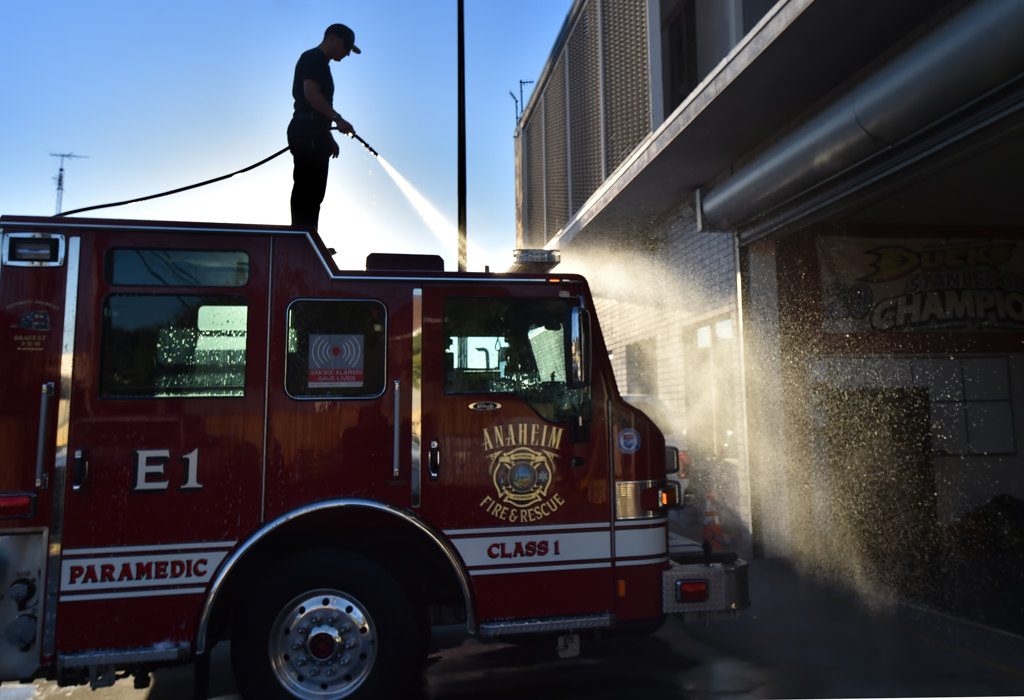
Capt. Nick Colonelli hoses down the top of Anaheim Fire & Rescue Engine 1 after getting it back from the maintenance yard. Photo by Steven Georges/Behind the Badge OC
Station 1 also is home to AF&R’s innovative CCRU, for Community Care Response Unit, an urgent care on wheels staffed by Capt. Kevin Kane and Nurse Practitioner Victoria Morrison. Their job is to treat patients in the field when possible, instead of having them transported to a hospital.
On a firehouse shift, everyone knows his or her assigned role, and there’s little discussion about who is doing what during calls.
The teams work together seamlessly.
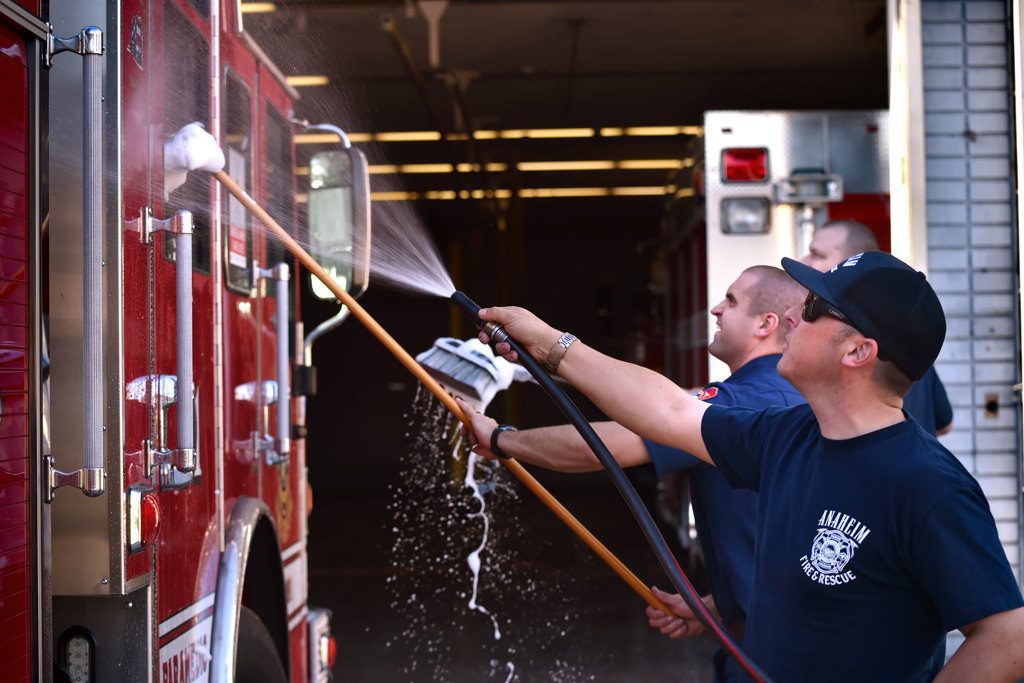
Anaheim Fire & Rescue Station 1 firefighters use their time between calls to wash down Engine 1. Photo by Steven Georges/Behind the Badge OC
Sometimes, after a call, a superior will offer tips to a rookie firefighter about things that could have been done differently — and, perhaps, better.
Each shift, the goal of the firefighters is to roll out of the station within 90 seconds of getting a call to carry out their primary mission:
Save lives and property.
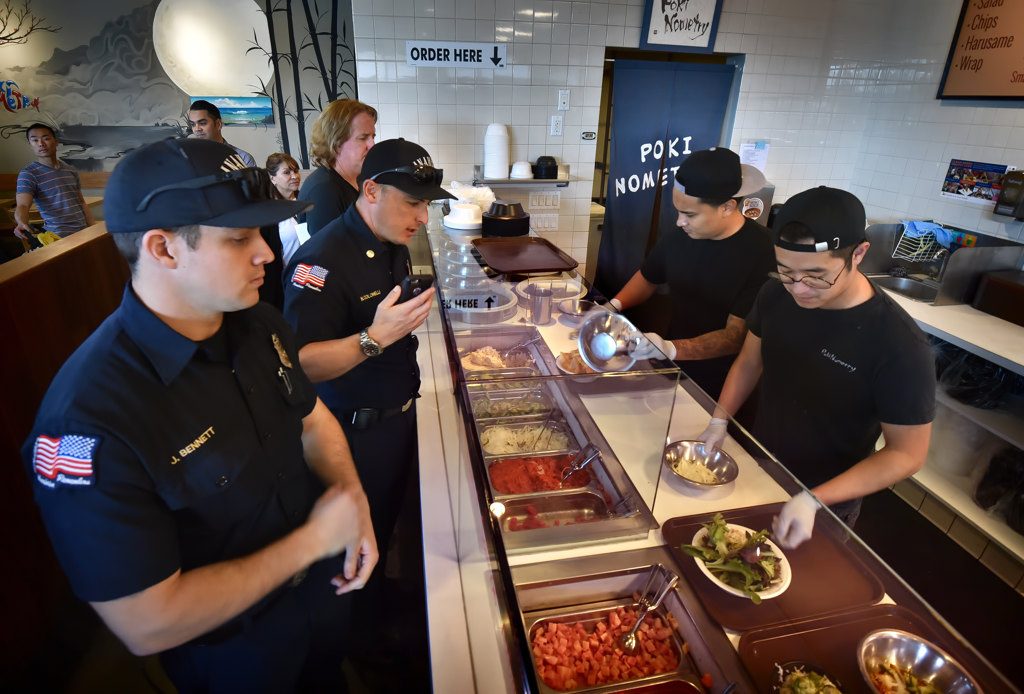
After numerous calls prevented them from picking up lunch supplies from a supermarket, Firefighters Jamison Bennett, left, and Capt. Nick Colonelli order sushi.
Photo by Steven Georges/Behind the Badge OC
And the work comes with sights, smells and sounds that would stop a non-first responder cold.
At one time, there were three engine/fire companies housed in Station 1. Now there are two, along with a Type 3 wildland fire rig and a “rehab support” rig with side awnings for shade, as well as drinks and snacks. The rehab support rig is a kind of mobile aid station for fatigued firefighters.
Station 1 also is stocked with extra SCBAs (for self-contained breathing apparatus) and other equipment that firefighters from other stations check out when they need it in a pinch.
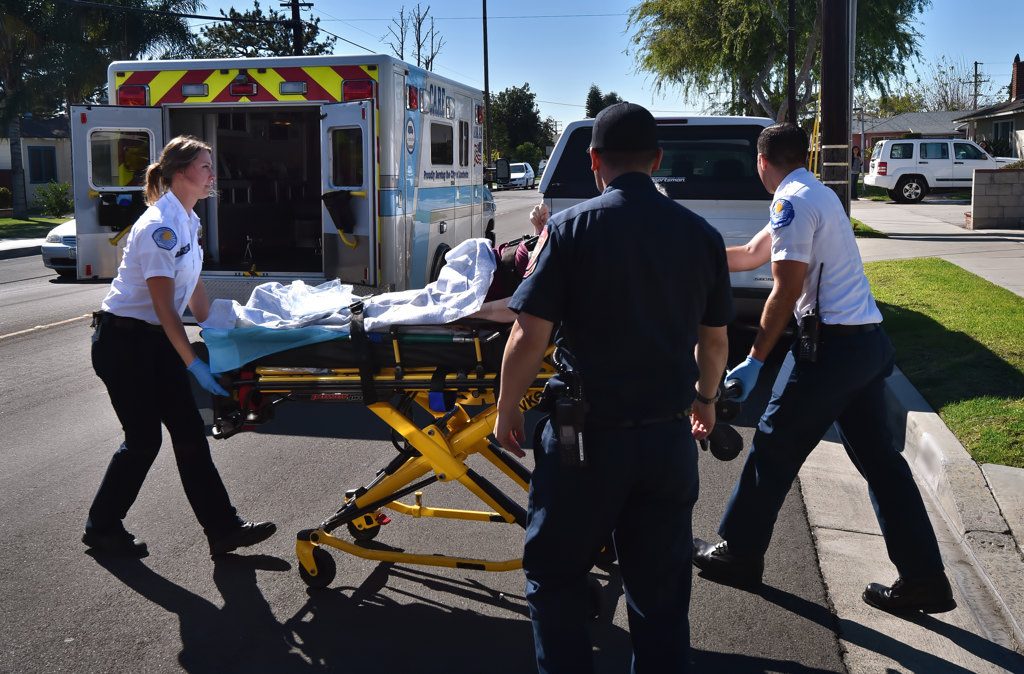
EMTs from CARE Ambulance transport a patient deemed in need of hospital care.
Photo by Steven Georges/Behind the Badge OC
During this 24-hour shift, from 8 a.m. Friday through 8 a.m. Saturday, Truck 1 ended up responding to eight medical aid calls and one regarding a reported fire in a park.
Engine 1, lead by Capt. Nick Colonelli and including Firefighter Paramedic Jamison Bennett, Engineer Mark Edinger and Probationary Firefighter Patrick Collins, responded to eight calls.
The bulk of the calls for both companies came in a flurry from the late afternoon rush hour to early evening.
In what the Shift A firefighters say was unusual for a Friday night, most of them got in a solid five hours of sleep.
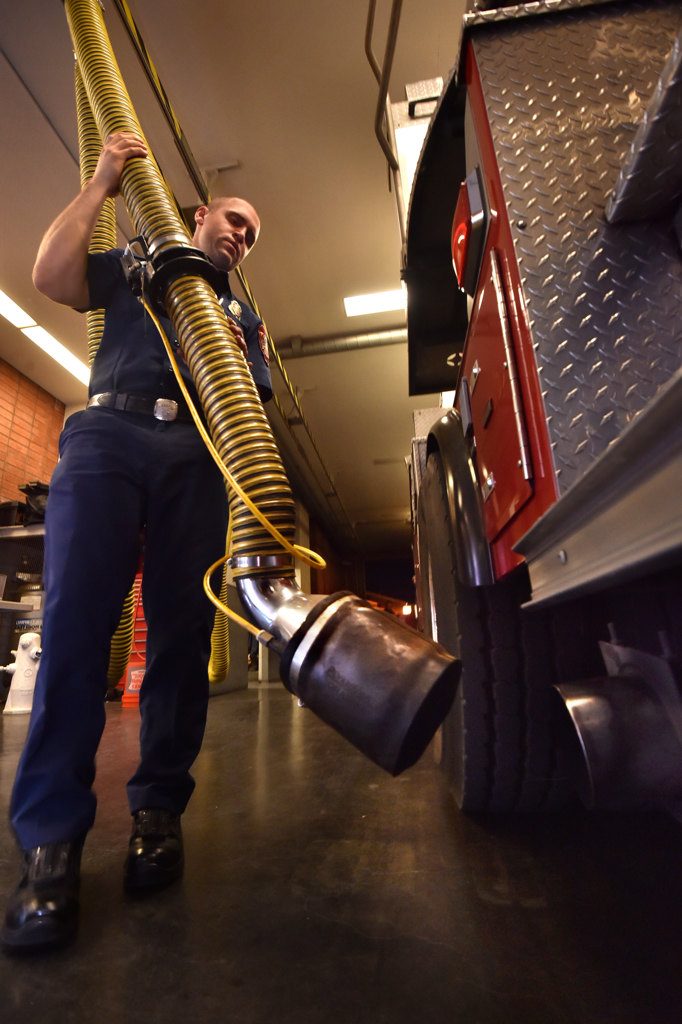
Anaheim Fire & Rescue Probationary Firefighter Ryan Allred attaches a special hose to the tailpipe of Truck 1 designed to reduce exhaust fumes inside the fire station’s apparatus bay. The hose automatically comes off just as the truck leaves the station.
Photo by Steven Georges/Behind the Badge OC
Between calls, there was little down time.
In addition to training, one firefighter had to go to a medical office to complete his annual physical, and Engine 1 had to go to the Anaheim City Yard to get its usual rig, which had been in maintenance for a couple of weeks.
Planned morning and evening workouts in the station gym got scrapped because of the timing and volume of calls.
The biggest call, which required the response of both Truck 1 and Engine 1, as well as units from another AF&R station, was a traffic accident on the southbound 57 Freeway near the Katella Avenue exit that shut down all but the carpool lane and stopped traffic to a crawl.
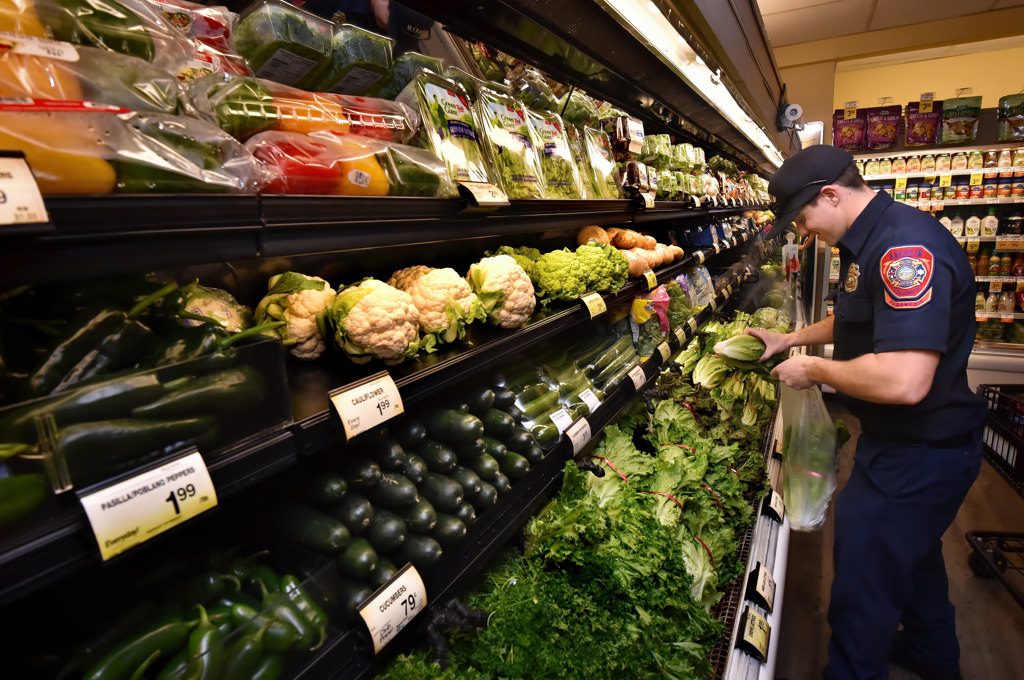
Anaheim Firefighter Paramedic Jamison Bennett shops in the fruits and vegetables section for dinner.
Photo by Steven Georges/Behind the Badge OC
That call, which involved three vehicles and seven patients, came into Station 1 just before 5 p.m.
Fortunately, all patients escaped with mild to moderate injuries.
Firefighters had to use a “Jaws of Life” hydraulic tool to extricate five family members from their Toyota Highlander, which had flipped but landed upright.

Anaheim Fire & Rescue Firefighters Jamison Bennett, left, Patrick Collins and Mark Edinger shop for food for dinner for the crews at Fire Station 1 on Friday, Feb. 16. During their shift, firefighters can be called at any time and must drop whatever they’re doing and race to a call.
Photo by Steven Georges/Behind the Badge OC
Typically, firefighters try to eat lunch around noon and dinner at 5 p.m., with each contributing $20 per day ($16 for the meals, $4 that go toward snacks and other staples stocked on shelves in the station’s industrial-sized kitchen).
Firefighters shop and eat together because they have to immediately roll to calls as they come in.
Bennett, of Engine 1, steps up as head chow person for the shift. He plans to serve cashew chicken salad pita sandwiches for lunch and Chinese chicken salad for dinner.
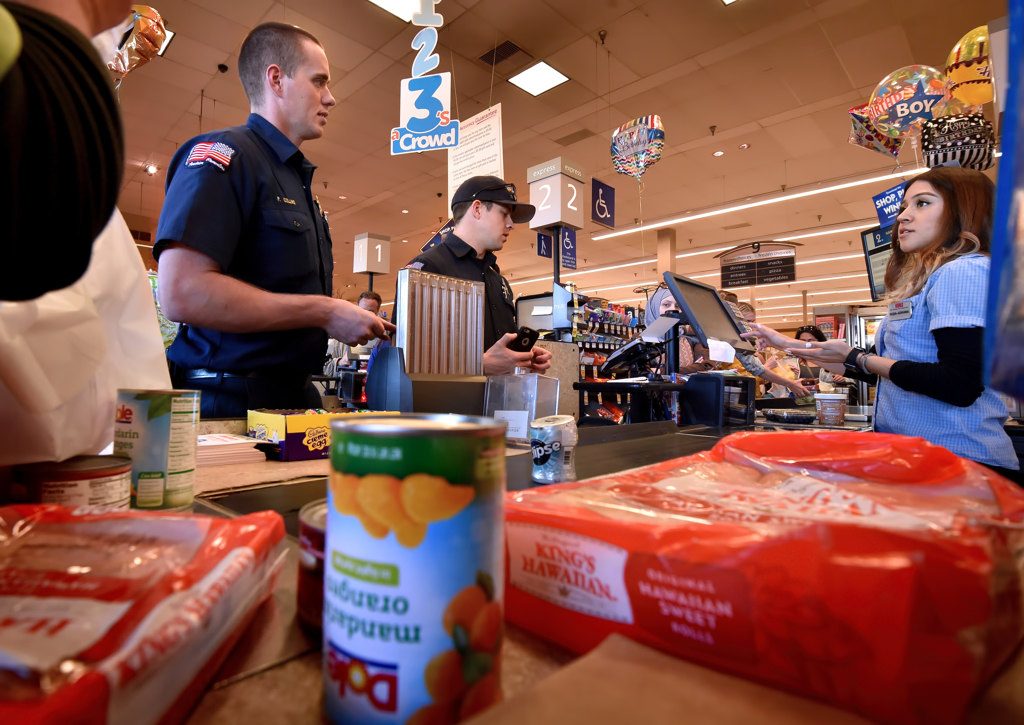
Probationary Firefighter Patrick Collins, left, and Firefighter Paramedic Jamison Bennett check out food for dinner at Station 1. Firefighters all chip in and pay for their own meals during shifts. Photo by Steven Georges/Behind the Badge OC
But just 30 or so feet into a Vons grocery run at 11:10 a.m. Friday, a medical aid call comes in.
“There go our lunch plans,” Bennett says as he and his Engine 1 partners roll to a mobile home park to tend to a man in his 50s who has seizure-like symptoms.
After that call, the debate starts:
Del Taco or poke bowls for lunch?
The crew of Engine 1 settles on PokiNometry, a popular sushi restaurant in downtown Anaheim.
They are back at Station 1 by 12:30 p.m.
“All right, let’s chow,” Bennett announces.
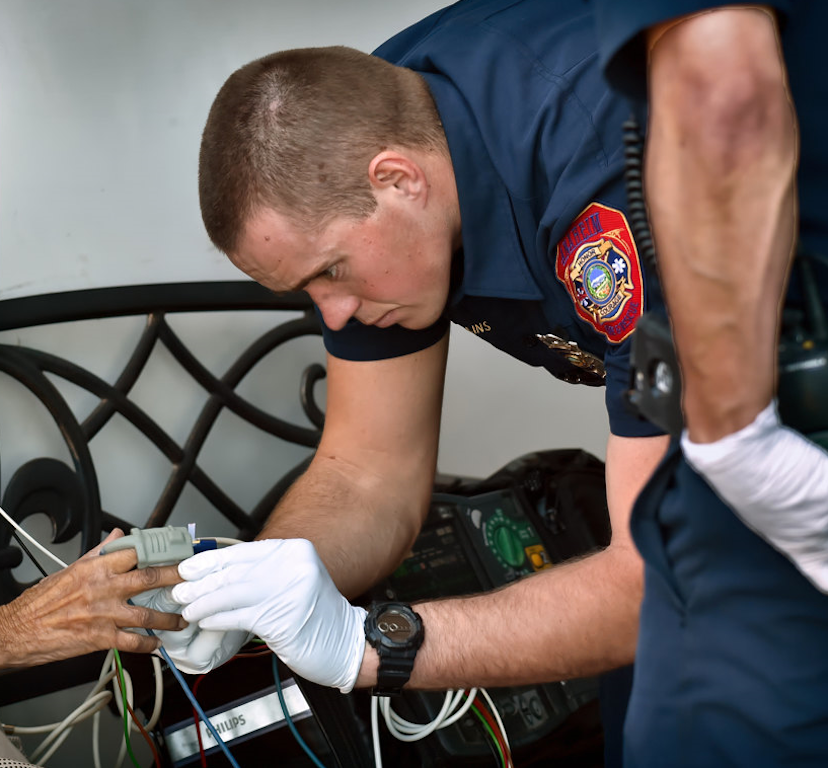
Probationary Firefighter Patrick Collins checks a woman’s vitals. Photo by Steven Georges/Behind the Badge OC
“Sometimes,” he notes, “the hardest part of a shift is getting the food.”
The crew on Truck 1, on a call concerning a possible heroin overdose, returns to the station around 2:20 p.m. to scarf down on Mexican takeout.
“Meals are important,” Colonelli says. “They’re the glue, the camaraderie. They are what gets you through the 72s (three 24-hour shifts in a row), the long work hours.”
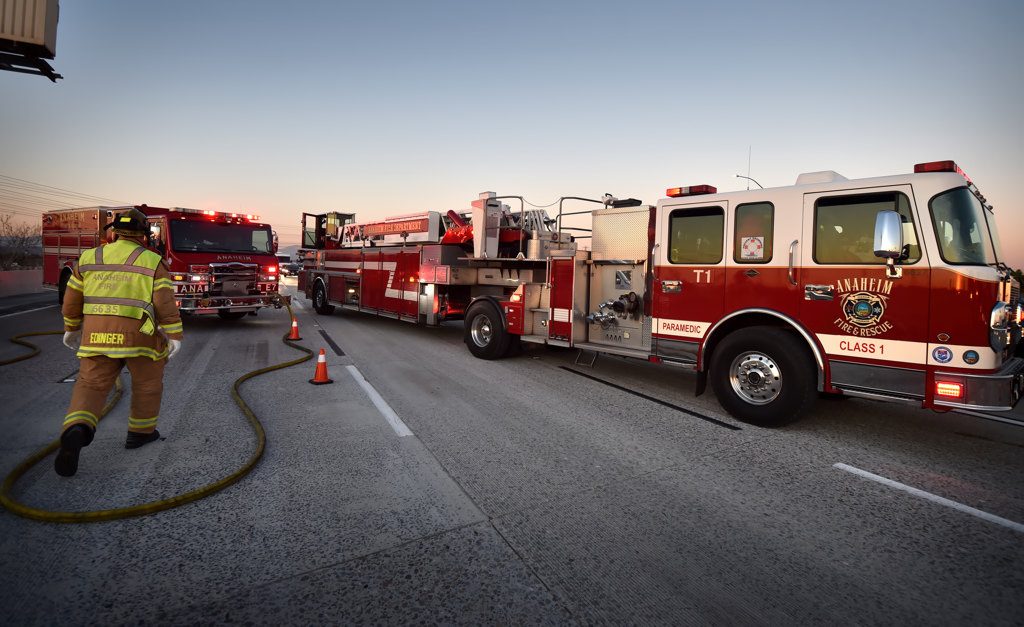
AF&R Engineer Mark Edinger walks back to Truck 1 after helping rescue passengers trapped inside an SUV involved in a multi-vehicle crash on the southbound 57 Freeway that closed all but one lane just after 5 p.m. on Friday, Feb. 16.
Photo by Steven Georges/Behind the Badge OC
Typically, the captains give their crew members “free time” between around 1 p.m. and 3 p.m. to study or train and to allow the captains to get caught up on reports.
But there’s no “typical” at a firehouse.
A medical aid call comes in at 1:08 p.m. and at 2 p.m., the Shift A firefighters huddle around the chow table to watch a training video about new portable radios.
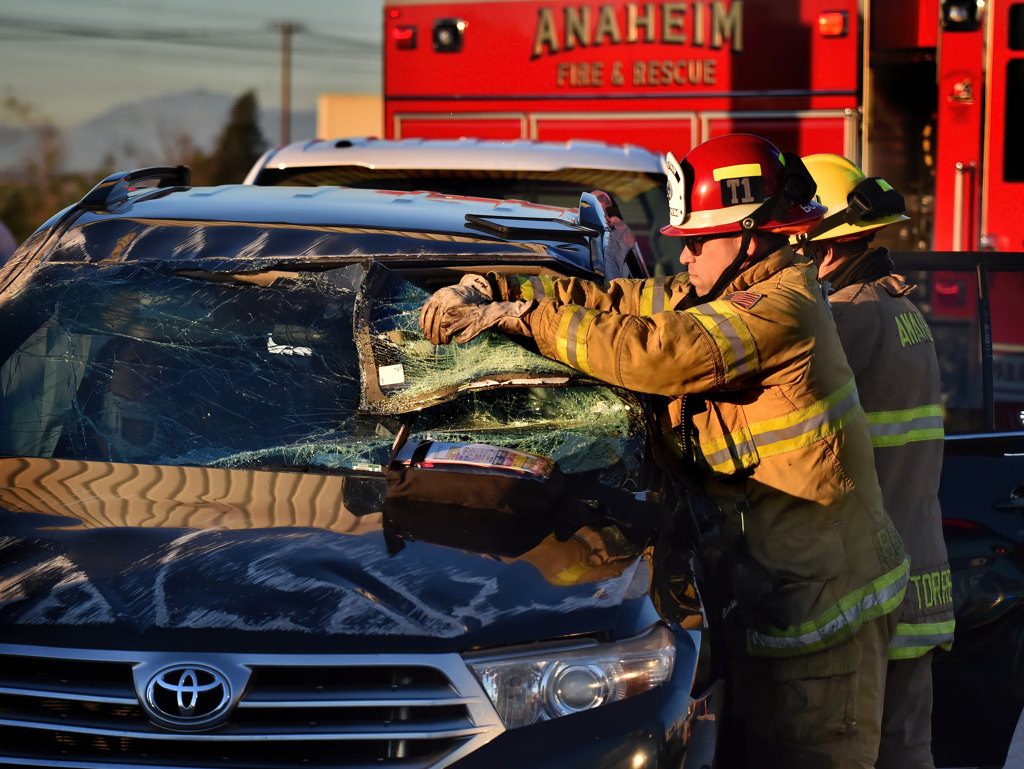
Anaheim Fire & Rescue Capt. Michel Bowidowicz peels back a smashed windshield from an SUV that overturned and landed right side up on the 57 Freeway.
Photo by Steven Georges/Behind the Badge OC
At 4:47 p.m., Bennett starts cutting chicken for his Chinese chicken salad — enough to feed more than a dozen.
At 4:53 p.m., the firefighters respond to a traffic accident.
There’s another traffic accident at 6:33 p.m. that further delays preparation of dinner.
After a handful of other calls — including one about an open fire in a park that turns out to be a group of homeless men cooking dinner in a barbecue (“Use charcoal next time,” Bowidowicz advises them) — the firefighters finally sit down for dinner at 8:30 p.m.
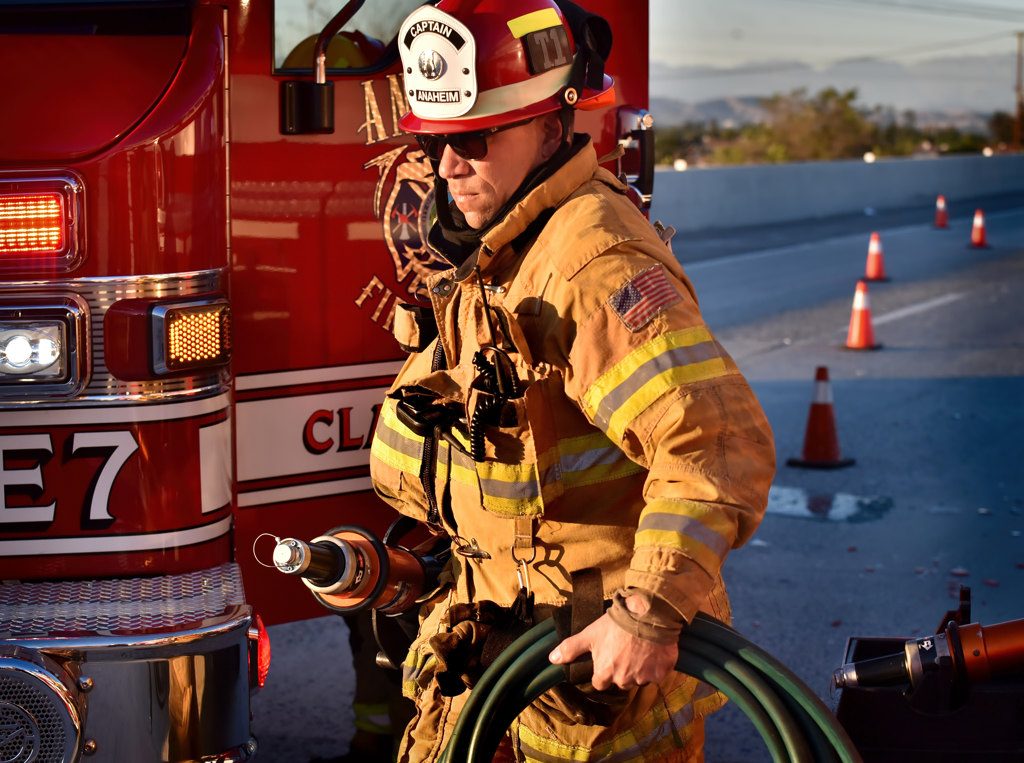
Capt. Michel Bowidowicz carries “Jaws of Life” equipment from Truck 1 to a car that overturned on the 57 Freeway.
Photo by Steven Georges/Behind the Badge OC
As is customary, the EMTs — on this shift, Austin Jones and Nick Torres — are served first, after guests.
Truck 1 goes out at 12:11 a.m. Saturday on a traffic accident. A male is blocks from his home in Anaheim, about to get handcuffed and taken to the Anaheim PD jail on suspicion of DUI.
According to APD Traffic Investigator John Roman, the suspect met up with a date he arranged via a social media app in Torrance, and was returning home with his date when he turned left at a green light and nearly hit an approaching car head on.
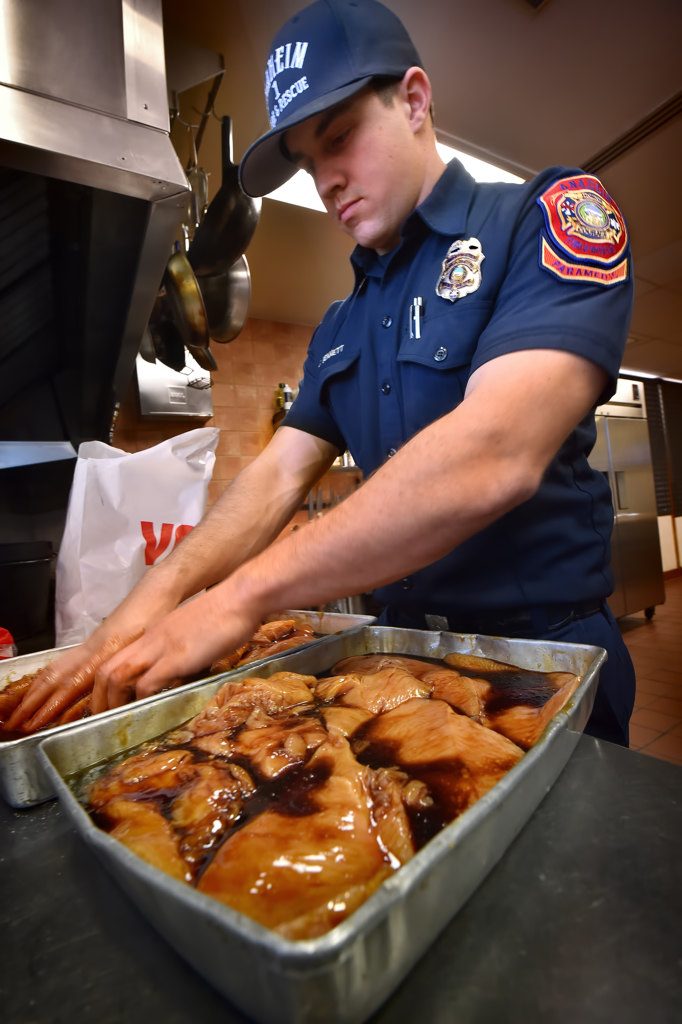
Firefighter Paramedic Jamison Bennett marinades chicken in soy sauce and sweet and savory cooking sauce for Chinese chicken salad dinner at AF&R Station 1 on Feb. 16.
Photo by Steven Georges/Behind the Badge OC
The two men in the car request evaluation at an ER.
The DUI suspect’s date summons an Uber to take her home to Torrance.
“You get to see a lot of bad choices out here,” Roman says.
Shortly after that call, in another Uber-related incident, an off-duty California Highway Patrol officer needs to be transported from one hospital to a higher-level one.

Firefighter Engineer Mark Edinger dishes up some chicken for dinner.
Photo by Steven Georges/Behind the Badge OC
For unclear reasons, a man slugged him in the back of the head while the victim and his date were about to get into an Uber car after a country music concert at House of Blues.
The victim, 39, suffered subdural bleeding and a skull fracture.
Truck 1 served as a taxi in what is known as a critical care transport call.
Truck 1 is back at the station at 2:47 a.m.
“What have we learned tonight?” Capt. Bowidowicz asks his crew on the drive back.
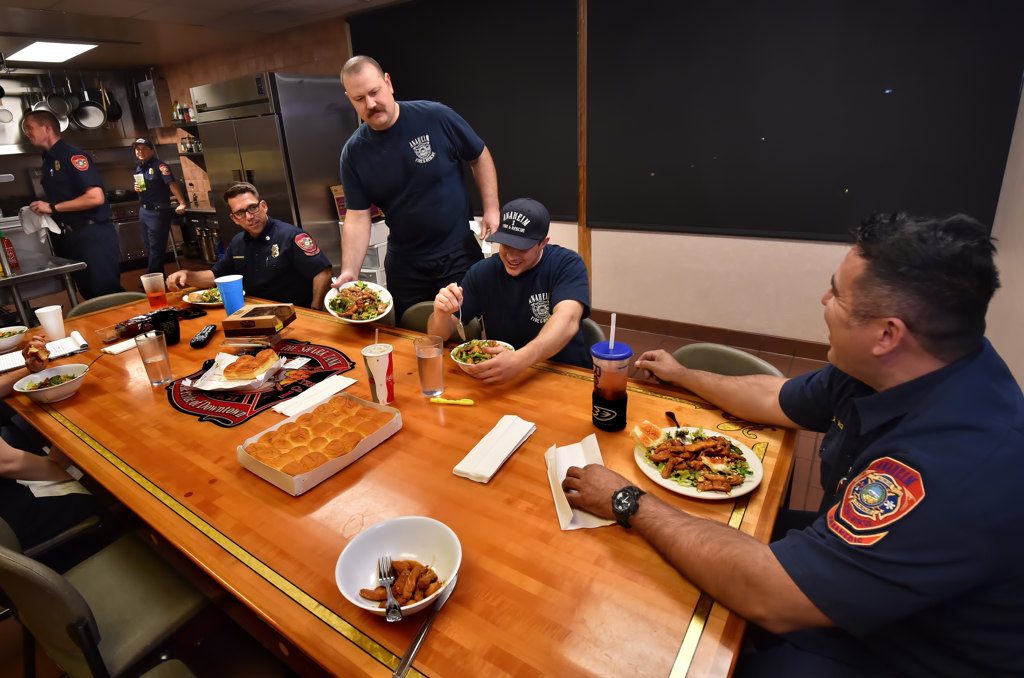
After a series of back-to-back calls, firefighters from Anaheim Station 1 finally get their chance to sit down for dinner at 8:30 p.m. on Friday, Feb. 16.
Photo by Steven Georges/Behind the Badge OC
“Just stay home,” Firefighter Engineer Pope says.
Nothing good, the two agree, happens on the streets after midnight.
 Behind the Badge
Behind the Badge
